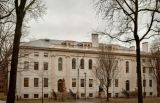The University System of Georgia conducted a two-year survey that showed very low utilization rates for the schools' classrooms, the Florida Times-Union reported Saturday.
Chancellor Hank Huckaby reportedly told the board in 2011 the reason for launching this study was to cope with economic realities.
"In this new environment, the major challenge is not building capacity: It is first to ensure the existing capacity is used as efficiently and effectively as possible," he told the Florida Times-Union. "Accordingly, we must ensure that we are utilizing our entire space well before new buildings are approved."
According to the report, the average classroom (440 in total) at the University of Georgia (UGA) is used for 18.5 hours during the 40-hour workweek. When being used, seats are only two-thirds full, adding up to a 31 percent utilization rate.
The 54 classrooms of the College of Coastal Georgia are being used a mere 14.7 hours per 40-hour workweek, the study said. With their seating being just above two-thirds full on average, their utilization rate came in at 26 percent.
Armstrong Atlantic State University had very similar numbers as UGA, only on a smaller scale. The 101 rooms are being used 18 hours per 40-hour workweek with 72 percent of seating occupied, making their utilization rate 32 percent, said the study.
Georgia Gwinnett College had the highest utilization rate, 77 percent, which was five times the lowest.
Alan S. Travis, the system's director of planning, oversaw the 64-site study and he told the Florida Times-Union that fixing such a problem is not quite simple.
"While each of these campuses could increase its classroom utilization rate, each also has individual characteristics that affect the components of utilization [time and seat occupancy]," he said.
Schools with older buildings like the Savannah State University do not have the same flexibility as some of the newer buildings do, Travis noted.
Other things that need to be taken into consideration are logistical and scheduling factors. Students and faculty have to be able to go from one building to the next in a reasonable amount of time without rushing or traveling an excessive distance.
The last factor, and probably the most unavoidable one, is the rise in online courses. With their growing popularity it is lessening the amount of students in the classroom at schools all over.
© 2025 University Herald, All rights reserved. Do not reproduce without permission.








